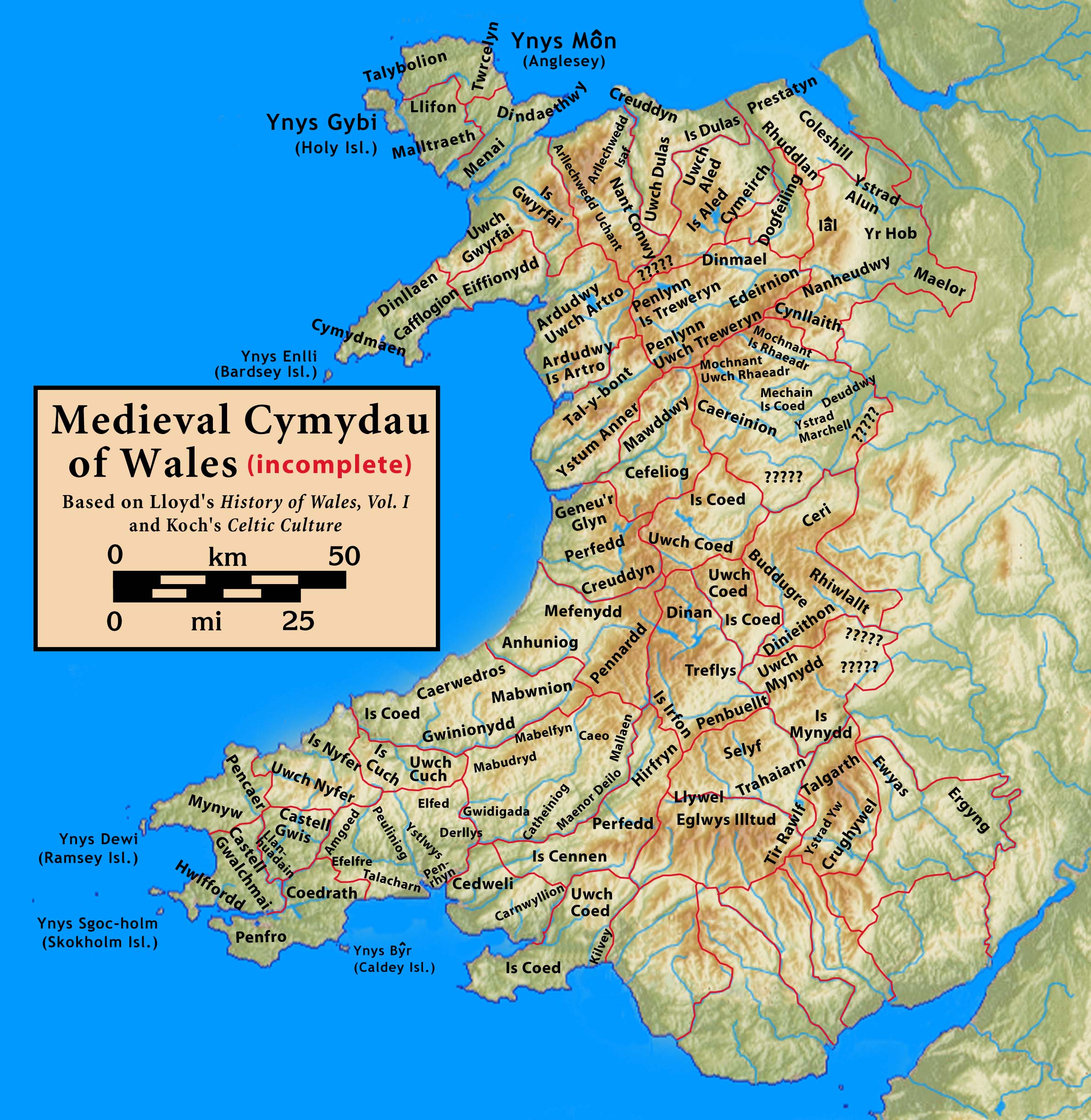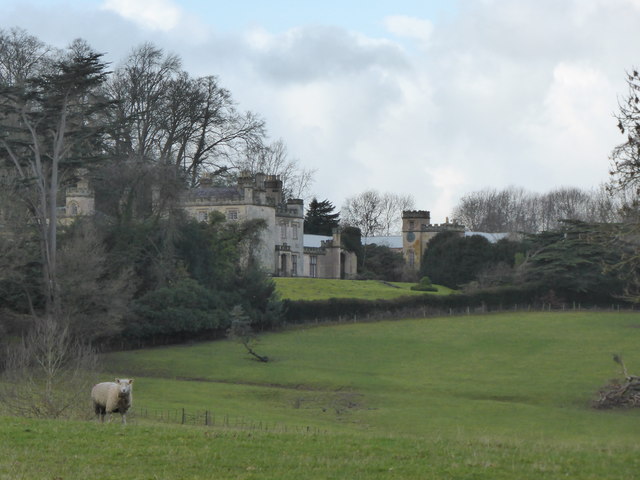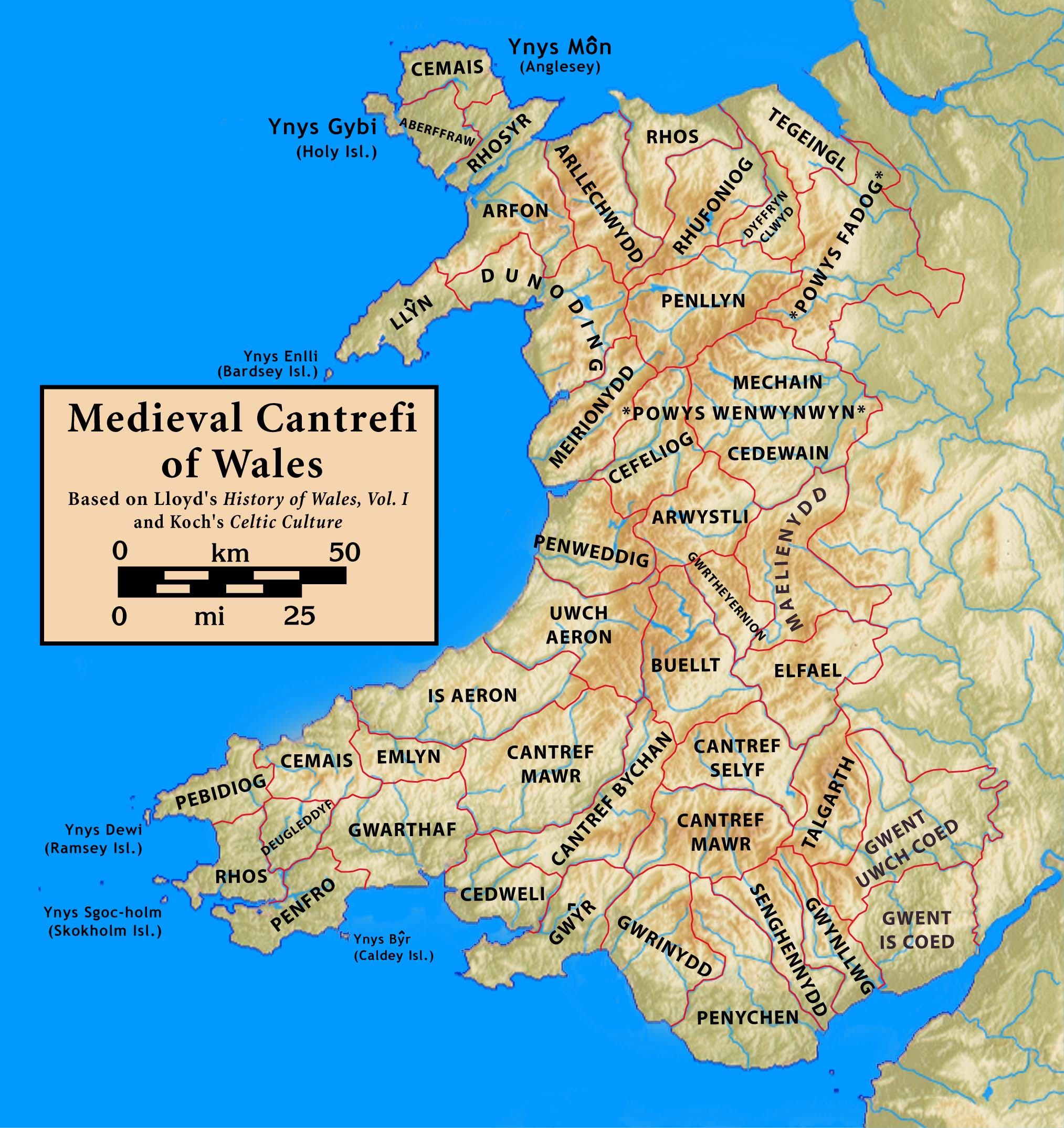|
Ystlyg
Ystlyg () was a medieval cantref in the Kingdom of Powys. It lay at the east of the kingdom on the border with England. It consisted of the commotes (''cymydau'') of Deuddwr in the north, Ystrad Marchell in the centre, Llannerch Hudol (also written Llannerchwdwl, Llanerchydol or Llannerchudol) in the south, and Y Gorddwr (or Corddwr) in the east beyond the River Severn and Offa's Dyke. Ystad Marchell, Llannerch Hudol and Deuddwr formed the ''Teirswydd'' (English: three ommotes(literally, swydd is ''post'' as in an office)) which were among the lands restored into the possession of Gruffydd ap Gwenwynwyn in return for his homage and fealty by Llywelyn ap Gruffudd at Ystumanner in 1263. Y Gorddwr had remained under the control of the Corbet family (barons of Caus) and therefore the English king. The cantref of Ystlyg (excluding Y Gorddwr) corresponds to the later hundred 100 or one hundred (Roman numerals, Roman numeral: C) is the natural number following 99 (number), 99 ... [...More Info...] [...Related Items...] OR: [Wikipedia] [Google] [Baidu] |
Commote
A commote (, sometimes spelt in older documents as , plural , less frequently )'' Geiriadur Prifysgol Cymru'' (University of Wales Dictionary), p. 643 was a secular division of land in Medieval Wales. The word derives from the prefix ("together", "with") and the noun ("home, abode"). The English word "commote" is derived from the Middle Welsh . The basic unit of land was the , a small basic village or settlement. In theory, 100 made up a (literally, "one hundred settlements"; plural: ), and half or a third of a was a , although in practice the actual numbers varied greatly. Together with the , commotes were the geographical divisions through which defence and justice were organised. In charge of a commote would be a chieftain probably related to the ruling Prince of the Kingdom. His court would have been situated in a special , referred to as a . Here, the bonded villagers who farmed the chieftain's estate lived, together with the court officials and servants. Commotes were f ... [...More Info...] [...Related Items...] OR: [Wikipedia] [Google] [Baidu] |
Deuddwr
; ; ) was a medieval commote (''cwmwd'') in the cantref of Ystlyg in the Kingdom of Powys. It lay at the east of the kingdom, bordering England to the north, the cantref of Mechain to the north-west and, within Ystlyg, the commotes of Ystrad Marchell to the south and Y Gorddwr to the east. It is also between the River Vyrnwy in the north-east and the River Severn in the south-east, they meet at the east of the commote, hence its name. The cantref of Ystlyg (excluding Y Gorddwr) corresponds to the later hundred of Deuddwr. The name of this hundred has been corrupted to Deythur or Deytheur. The name occurs in modern placenames, e.g. the parish of Llansantffraid Deythur and the village of Deuddwr south-east of Llansantffraid-ym-Mechain. Together with Llannerch Hudol and Ystrad Marchell it formed the ''Teirswydd'' ("three commotes") which were among the lands restored into the possession of Gruffydd ap Gwenwynwyn in return for his homage and fealty by Llywelyn ap Gruffudd Lly ... [...More Info...] [...Related Items...] OR: [Wikipedia] [Google] [Baidu] |
Ystrad Marchell
; sometimes ''Strad Marchell'') was a medieval commote () in the cantref of Ystlyg in the Kingdom of Powys. It roughly coincides with the parish of Welshpool. It lay at the east of the kingdom, bordering the cantref of Caereinion to the west and south, and the cantref of Mechain to the north-west. Within Ystlyg the other commotes were Deuddwr to the north, Llannerch Hudol to the south and Y Gorddwr (or Corddwr) to the east. The cantref of Ystlyg (excluding Y Gorddwr) corresponds to the later hundred of Deuddwr. Ystrad Marchell was founded by or named for Marchell, a sister of the fifth or sixth century saint Tyfrydog. She was also a saint and is associated with Capel Marchell near Llanrwst, and Ffynnon Farchell () and St Marcella's Church, in Eglwys Wen near Denbigh. The valley of Ystrad Marchell is the site of the medieval Cistercian monastery of Strata Marcella (Latinised form of ''Ystrad Marchell'', strata meaning ''paved road'' or ''causeway'') which was founded in ... [...More Info...] [...Related Items...] OR: [Wikipedia] [Google] [Baidu] |
Y Gorddwr
; also known as Corddwr) was a medieval commote () in the cantref of Ystlyg in the Kingdom of Powys. It was on the eastern side of the River Severn bordering England, on the west it was bordered by two of the other commotes of Ystlyg - Deuddwr in the north and Ystrad Marchell in the south. Its Welsh name could mean "the upper water"; ''gor-'' "upper-", ''dŵr'' "water". After the Norman Conquest, Y Gorddwr was claimed by Roger le Corbet, the Baron of Caus within the Marcher Lordship of Roger de Montgomery. In 1241, Gruffydd ap Gwenwynwyn regained most of the lands lost by his father, Gwenwynwyn in about 1216. Gruffydd immediately claimed the territory of Y Gorddwr by ancient inheritance, bringing him into conflict with the Corbet family. He was related to them through his mother, Margaret, who was a sister of Thomas Corbet, the baron of Caus at the time, this added weight to his claim. He inherited his mother's lands in Y Gorddwr in 1246, and appropriated more in 1252 while K ... [...More Info...] [...Related Items...] OR: [Wikipedia] [Google] [Baidu] |
Kingdom Of Powys
The Kingdom of Powys (; ) was a Welsh successor state, petty kingdom and principality that emerged during the Middle Ages following the end of Roman rule in Britain. It very roughly covered the northern two-thirds of the modern county of Powys and part of today's English West Midlands (see map). More precisely, and based on the Romano-British tribal lands of the Ordovices in the west and the Cornovii in the east, its boundaries originally extended from the Cambrian Mountains in the west to include the modern West Midlands region of England in the east. The fertile river valleys of the Severn and Tern are found there, and this region is referred to in later Welsh literature as "the Paradise of Powys" (an epithet retained in Welsh for the modern UK county). Name The name Powys is thought to derive from Latin ''pagus'' 'the countryside' and ''pagenses'' 'dwellers in the countryside', also the origins of French "pays" and English "peasant". During the Roman Empire, this regi ... [...More Info...] [...Related Items...] OR: [Wikipedia] [Google] [Baidu] |
Llanerchydol
Llanerchydol is a hamlet in Powys, Wales, situated on the A458 about 2 km west of the centre of Welshpool. It is part of the community of Welshpool and also lends its name to an electoral ward of Welshpool Llanerchyddol. Llanerchydol Hall Llanerchydol Hall is located in parkland between the A458 to Llanfair Caereinion and A490 to Llanfyllin. The hall, a largely intact early 19th-century picturesque Gothic Revival house, is a Grade II* listed building, and its well preserved park and gardens are listed, also at Grade II*, on the Cadw/ICOMOS Register of Parks and Gardens of Special Historic Interest in Wales. The site has a long history of occupation, including a Tudor house which burnt down in about 1776, after which David Pugh, a local man who made a fortune selling tea in London, bought the site and built a new house which became known as Llanerchydol Hall. David Pugh's great-grandnephew, also named David Pugh, inherited Llanerchydol Hall and became a local politici ... [...More Info...] [...Related Items...] OR: [Wikipedia] [Google] [Baidu] |
Cantref
A cantref ( ; ; plural cantrefi or cantrefs; also rendered as ''cantred'') was a Wales in the Early Middle Ages, medieval Welsh land division, particularly important in the administration of Welsh law. Description Land in medieval Wales was divided into ''cantrefi'', which were themselves divided into smaller commote, ''cymydau'' (commotes). The word ''cantref'' is derived from ''cant'' ("a hundred") and ''tref'' ("town" in modern Welsh language, Welsh, but formerly used for much smaller settlements). The ''cantref'' is thought to be the original unit, with the commotes being a later division. ''Cantrefi'' could vary considerably in size: most were divided into two or three commotes, but the largest, the ''Cantref Mawr'' (or "Great Cantref") in Ystrad Tywi (now in Carmarthenshire) was divided into seven commotes. History The antiquity of the ''cantrefi'' is demonstrated by the fact that they often mark the boundary between Welsh language#Dialects, dialects. Some were originally k ... [...More Info...] [...Related Items...] OR: [Wikipedia] [Google] [Baidu] |
Wales
Wales ( ) is a Countries of the United Kingdom, country that is part of the United Kingdom. It is bordered by the Irish Sea to the north and west, England to the England–Wales border, east, the Bristol Channel to the south, and the Celtic Sea to the south-west. , it had a population of 3.2 million. It has a total area of and over of Coastline of Wales, coastline. It is largely mountainous with its higher peaks in the north and central areas, including Snowdon (), its highest summit. The country lies within the Temperate climate, north temperate zone and has a changeable, Oceanic climate, maritime climate. Its capital and largest city is Cardiff. A distinct Culture of Wales, Welsh culture emerged among the Celtic Britons after the End of Roman rule in Britain, Roman withdrawal from Britain in the 5th century, and Wales was briefly united under Gruffudd ap Llywelyn in 1055. After over 200 years of war, the Conquest of Wales by Edward I, conquest of Wales by King Edward I o ... [...More Info...] [...Related Items...] OR: [Wikipedia] [Google] [Baidu] |
Llywelyn Ap Gruffudd
Llywelyn ap Gruffudd ( – 11 December 1282), also known as Llywelyn II and Llywelyn the Last (), was List of rulers of Gwynedd, Prince of Gwynedd, and later was recognised as the Prince of Wales (; ) from 1258 until his death at Cilmeri in 1282. Llywelyn was the son of Gruffudd ap Llywelyn ap Iorwerth and grandson of Llywelyn ab Iorwerth (also known as Llywelyn the Great, or Llywelyn I), and he was one of the last native and independent princes of Wales before its Conquest of Wales by Edward I, conquest by Edward I of England and English rule in Wales that followed, until Owain Glyndŵr held the title during his Glyndŵr rebellion, rebellion of 1400–1415. Genealogy and early life Llywelyn was the second of the four sons of Gruffudd ap Llywelyn ap Iorwerth, the eldest son of Llywelyn ab Iorwerth, and Senana ferch Caradog, the daughter of Caradoc ap Thomas ap Rhodri, Lord of Anglesey. The eldest was Owain Goch ap Gruffudd and there were two younger brothers, Dafydd ap Gruffy ... [...More Info...] [...Related Items...] OR: [Wikipedia] [Google] [Baidu] |
Hundred (county Division)
A hundred is an administrative division that is geographically part of a larger region. It was formerly used in England, Wales, some parts of the United States, Denmark, Sweden, Finland, Norway, and in Cumberland County in the British Colony of New South Wales. It is still used in other places, including in Australia (in South Australia and the Northern Territory). Other terms for the hundred in English and other languages include '' wapentake'', ''herred'' (Danish and Bokmål Norwegian), ''herad'' ( Nynorsk Norwegian), ''härad'' or ''hundare'' (Swedish), ''Harde'' (German), ''hiird'' ( North Frisian), ''kihlakunta'' (Finnish), and '' cantref'' (Welsh). In Ireland, a similar subdivision of counties is referred to as a barony, and a hundred is a subdivision of a particularly large townland (most townlands are not divided into hundreds). Etymology The origin of the division of counties into hundreds is described by the ''Oxford English Dictionary'' (''OED'') as "exceedingly ... [...More Info...] [...Related Items...] OR: [Wikipedia] [Google] [Baidu] |
Corbet Family
The Corbet family is an aristocratic English family of Anglo-Norman extraction, who were amongst the early marcher lords, holding the barony of Caus. Following the extinction of the senior line (and therefore the loss of the barony) the junior line based at Moreton Corbet Castle would go on to become one of the most powerful and richest of the landed gentry in Shropshire. The family trace their ancestry to two barons found in the 1086 Domesday Book and they probably came from the Boitron and Essay region, near Sées in Normandy. The name Corbet derives from the Anglo-Norman word ''corb'', meaning "crow" or "raven", matching the modern French ''corbeau''. Variants of the name include: Corbet, Corbett, Corbitt, Corbit, Corbetts, Corbete, Corben and possibly the variant of Corbin. The underlying derivation is from the Latin word ''corvus'', crow. Generally it is thought to be a jocular reference to a person who was thought to resemble a crow or raven: in hair colour, tone o ... [...More Info...] [...Related Items...] OR: [Wikipedia] [Google] [Baidu] |
Ynysymaengwyn
Ynysymaengwyn was a gentry house in the parish of Tywyn, Gwynedd (formerly Merioneth), situated near the left bank of the River Dysynni. The name means 'the white stone island'. Early history It was in the commote of Ystumanner or Ystum Anner that Gruffydd ap Gwenwynwyn did homage and swore fealty to Llywelyn ap Gruffudd on 12 December 1263. In return he was made a vassal lord and the lands taken from him about six years earlier were restored to him. The commote was in the cantref of Meirionnydd. From the late medieval period until the twentieth century, Ynysymaengwyn, situated roughly a mile from Tywyn by the road to Bryn-crug, was by far the most powerful estate in the parish. The family's wealth is revealed in official records and also in the Welsh poetry composed to its leading members. The estate may be traced back to the days of Gruffudd ab Adda of Dôl-goch and Ynysymaengwyn, bailiff of the commote of Ystumanner in 1330 and 1334, whose effigy is thought to lie in St ... [...More Info...] [...Related Items...] OR: [Wikipedia] [Google] [Baidu] |








